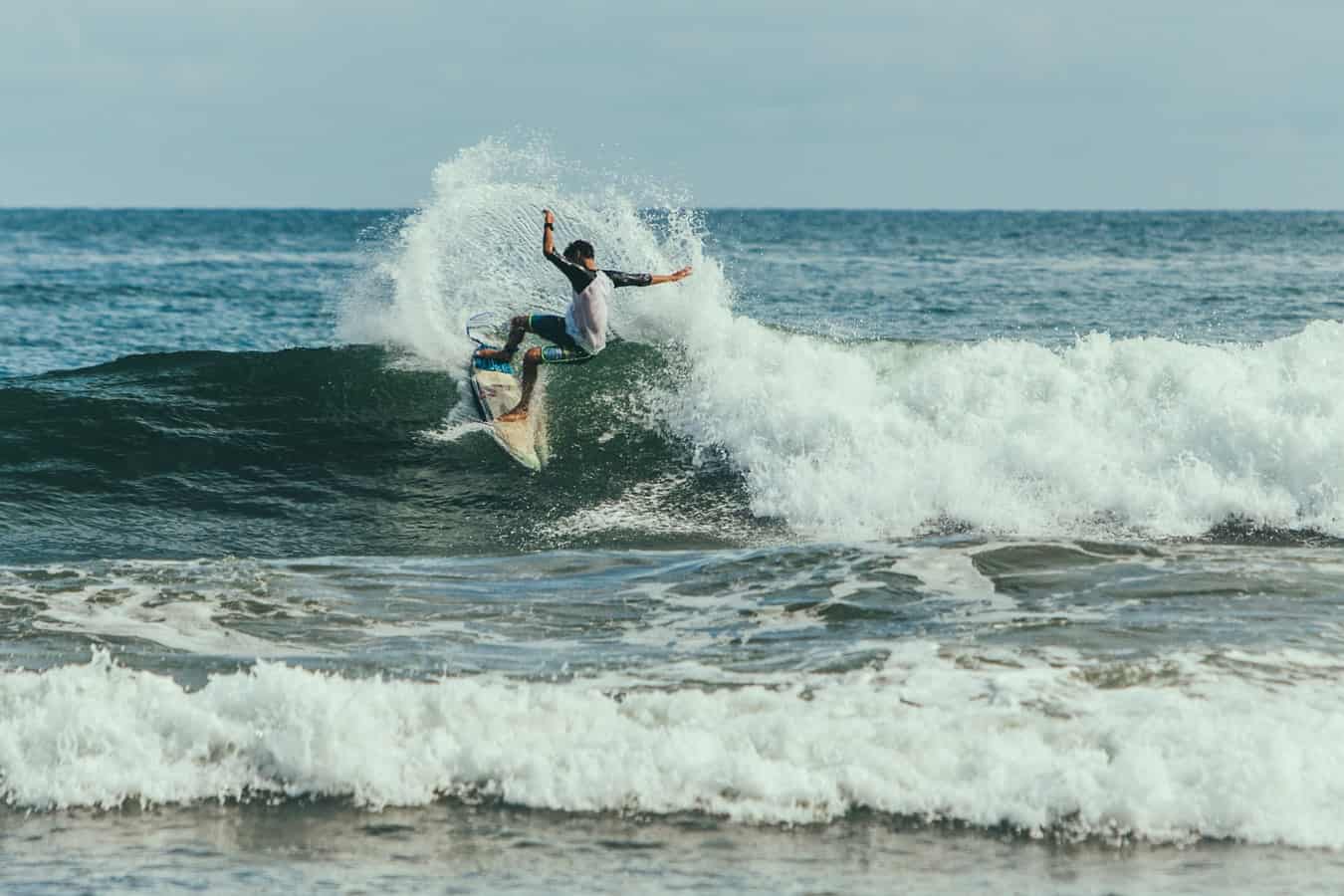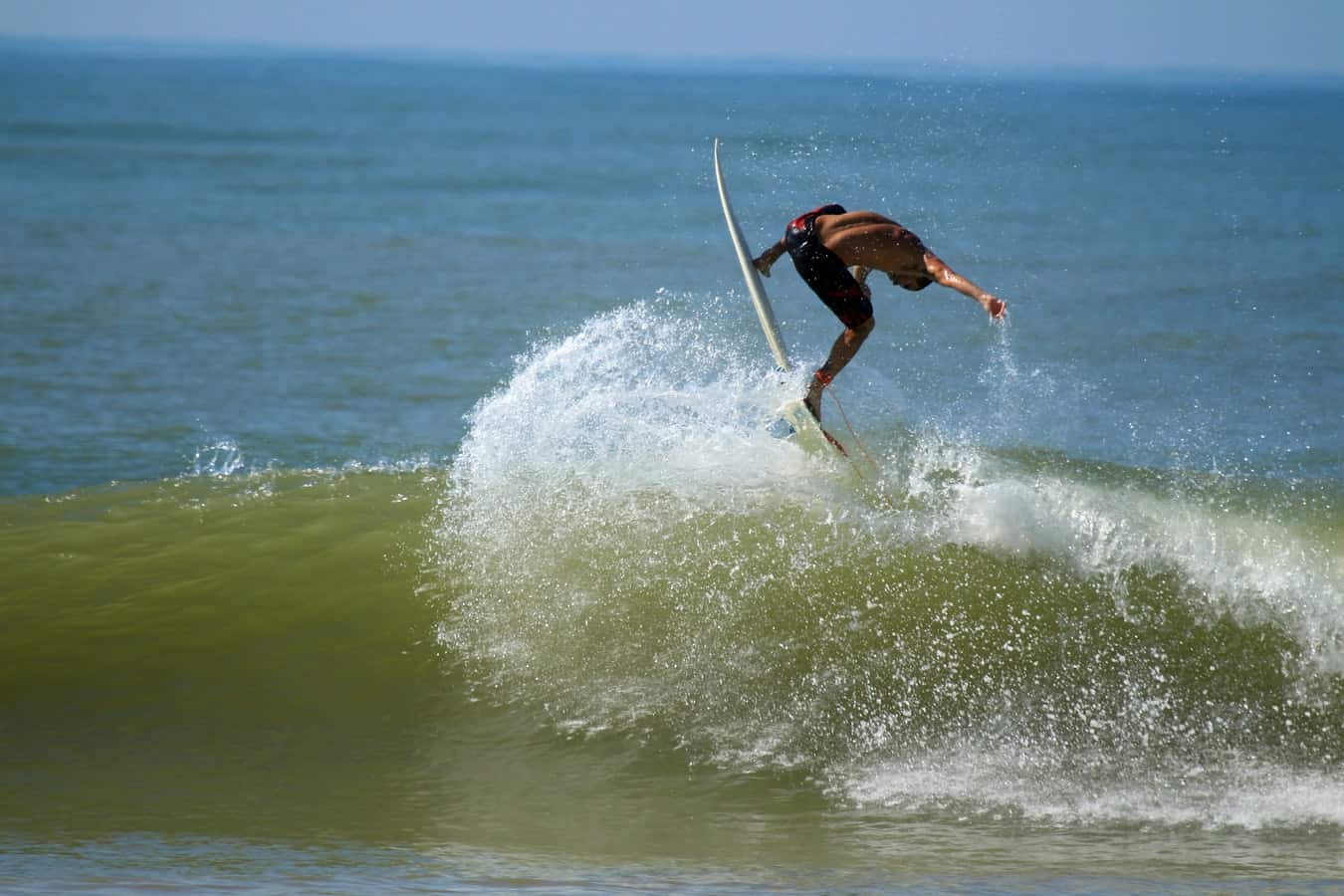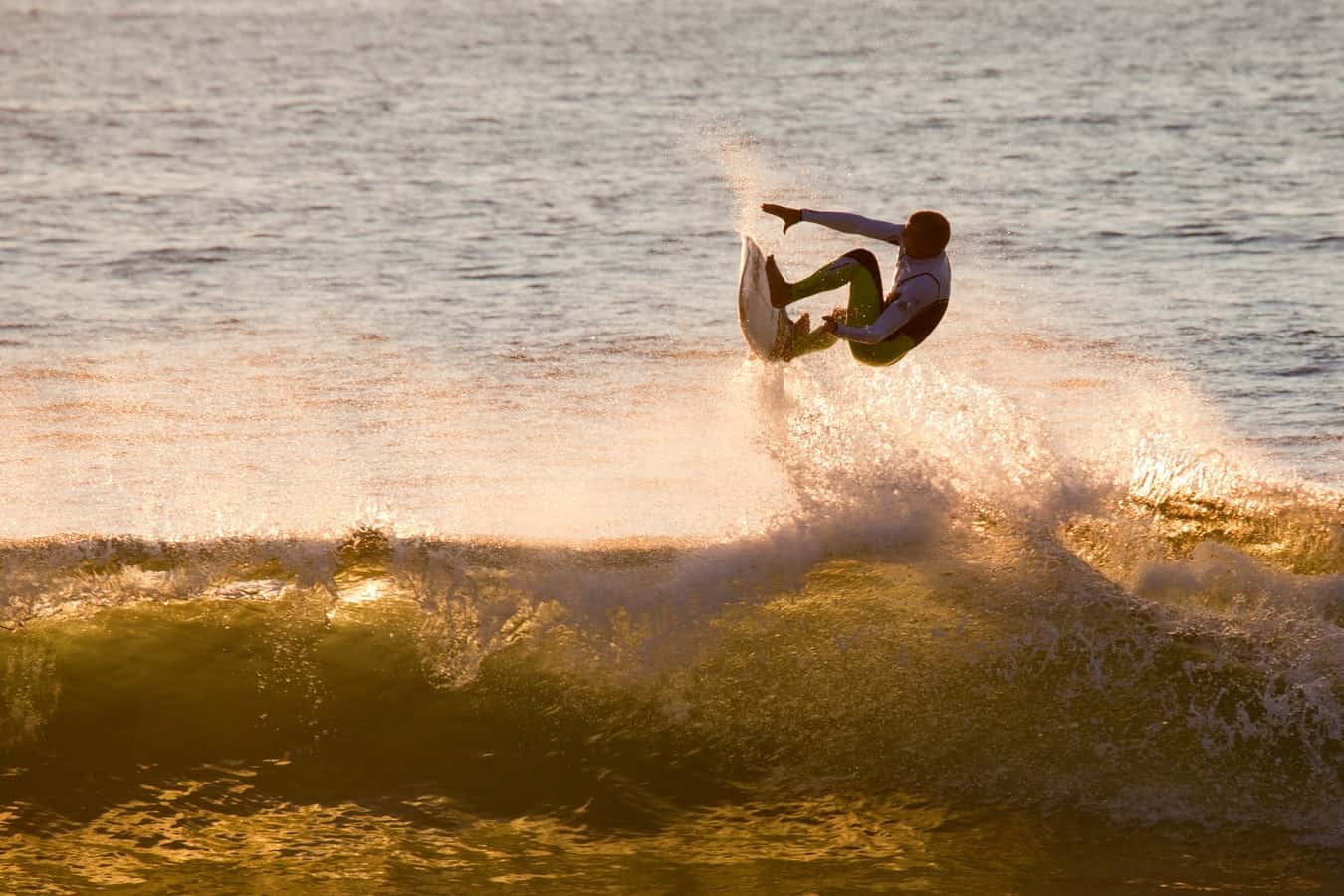It’s fair to say that surfing is one of, if not the most, slippery sport out there. Balancing on a board presents its own challenges but when you combine that with the force of a wave crashing behind you, it can certainly be tough to stay on. A number of different aspects keep you above sea level when you surf.
So how do surfer’s feet stay on the board? The answer is gravity, while buoyancy keeps the surfboard afloat, gravity pulls it and its rider toward the water. Gravity’s pull helps the rider hold his position on the moving, nearly-vertical face of a wave. The surfboard and its rider both have a center of gravity, which is related to their shape and mass.
How Does Gravity Affect Surfing?
The short answer is that gravity affects every single aspect of surfing. Everything about surfing, from the ability to stay afloat on the waves to the necessity of duck diving, comes from basic physics. Newton’s laws of motion, which describe the movement of matter, contribute heavily to maneuvering and staying afloat. Newton’s first law states that objects in motion, like waves, tend to stay in motion, while objects at rest, like a floating surfboard, tend to stay at rest. This is why a surfer has to paddle to catch a wave. According to Newton’s third law, every action has an equal and opposite reaction. When a rider pushes down one edge of the board, that edge pushes into the water, which pushes back up against the board. As a result, the board starts to turn.
What Other Physics Principles Affect Surfing?
A big principle that affects surfing is buoyancy. The surfboard’s buoyancy, or ability to float, comes from its density. The board is less dense than the water underneath it. The board’s coating is also waterproof, keeping water from seeping in, soaking the foam inside and pulling the board under. Surface tension is another important principle when surfing. The molecules that make up water are attracted to one another, so they create a surprisingly strong film at the water’s surface. This film is one reason why a wave holds it shape, and it helps keep the surfboard afloat.
Hydrodynamic forces also affect surfing. Hydrodynamic forces are essentially the same as aerodynamic forces. These forces, like lift and drag, can dramatically affect how waves form and how the waves interact with the surfer’s board.

How Does Your Surf Stance Affect How You Stay On Your Board?
Like skating, both your feet must be centered on the width or the center of gravity of the surfboard. Your feet arches should be positioned equally on each side of the stringer. Not standing up with your feet centered will most likely make you fall on the side on which you put more weight. Like almost every board sport, you have to figure out if you surf goofy or regular.
A “Regular Surfer”, surfs with their left foot forward on the board. A “Goofy Surfer” surf with your right foot forward. Skate stances abide by the exact same terminology. In most cases, surfers ride with their strongest foot (the foot you play with in soccer) at the back of the surfboard. However this isn’t always the case. For instance, I’m right foot dominant in soccer and ride goofy in both longboarding and skateboarding. A trick to figure this out is to have someone push you gently in the back. The first foot you instinctually put forward to stop you from falling will most likely be the one you put forward on the surfboard.
How Do You Pick The Right Surfboard?
Picking the right surfboard basically depends on four things: Your skill level, your height/weight, what waves you’ll be surfing and how often you’ll be surfing them. If you’re a beginner you should learn to surf on a longer-size board or a board with more floatation such as a longboard or soft top surfboard. These are wide, stable, boards perfect for small waves to learn on. Surfer pros make riding a short board look easy, but don’t be fooled into thinking that you can just hop on a small surfboard right out of the gate. Surfing is a lifelong pursuit, and choosing a small board to start will translate to a long, hard struggle. The opportunity cost of starting on a small board simply isn’t worth it. Learn the basics on a funshape or longboard, and then transition to a smaller board once you get a feel for the ocean and riding and catching waves.
Once you’re comfortable riding and catching waves in the water, you should explore your options when it comes to different surfboard designs. If hardcore shredding is what you seek, then you may want to step down from a longboard or mini-long to something smaller and more maneuverable, like a shortboard or fish surfboard. If you don’t want to take a huge step down, the fun-shape is a great option as it’s in between a short board and longboard style. Or if longboarding is more your style, then opt for a smaller, more performance-style longboard with lots of bells and whistles for nose rides and more performance longboarding.
How Does Height And Weight Affect Which Surfboard You Should Get?
Weight is a very important factor in selecting a board. If you are a light person (under 200lbs) then smaller boards will be easier for you to paddle and turn. If you are heavy (200 lbs. +) then try to stick with a longer, thicker board. Remember, when in doubt, always go with a larger size surfboard with more length and width due to its added buoyancy.
How Does Wave Type Affect Which Surfboard You Should Get?
When getting a new board, you need to assess the types of waves you will be riding with your surfboard. Like most of us, you probably live where the waves are small in the 1 foot to 4 foot range most of the time. If your local surf break is a slower, mushier wave, then boards like longboards and fishes come in handy. If you want to try your hand at a steeper wave, then having a short board or smaller size board always helps as they fit the geometry of the steep wave face better. Maximize your fun and pick the correct board for the type of waves you will be riding.
Surfing takes a lot of commitment to become an expert. When you first get started, you really need to assess your overall commitment, as it’s important in your board choice. If you think it’s just a weekend thing or something you only do once in a while, you should always go for the longer board such as a longboard or mini-long. Or if you ride shorter boards, try a short board or fish a few sizes bigger. Nothing is worse than struggling on a tiny board when you only get out once a week or a few times a month and the goal is to maximize wave count.

Does The Leash Help You Stay On The Board?
Many surfers wear a leash. A leash is a cord that’s connected to the board at one end and attached to a velcro cuff on the surfer’s ankle at the other end. This way when you fall off, your board doesn’t float away. The force of gravity pins them to the surface on which their weight rests. Though the leash is helpful for keeping track of your board and keeping other surfers safe, it doesn’t affect how your feet stay on the board itself.
How Does Board Wax Factor Into Staying On Your Board?
Wax adds a high-traction layer of bumps to the board’s deck, or standing surface to help you stay on the board via friction. Different types of wax are also suited for different water temperatures. The wax layer helps the rider stay on the board, and it gradually wears out during use. Surfers can then add a new topcoat of wax or remove the basecoat with a wax comb and start with a completely fresh wax job.
The Science Behind Waxing Your Board
Friction is the physical description of the force exerted between two surfaces in contact with each other. In the example of surf wax, when you press onto the board you body applies a force onto the surface of the board. This force has two parts, there is a force into the surface and then there is another force parallel to the surface of the board. Friction comes in with the parallel force. A frictional force is created at the surface of your body and the board which is equal to force that say, your foot imparts to the board.
This frictional force is equal to the “Coefficient of Friction” times the normal force. The frictional force is very dependent on the coefficient of friction for any given normal force. Note that when you are standing upright, the normal force is essentially how much you weigh, so your only hope for more friction is to either get heavier, or increase the coefficient of friction. When wax makers claim they are “sticky” they’re saying that their wax has a higher coefficient of friction. There are many other features to wax as well, such as durability and ease of application. But in terms of functionality, stickiness and the coefficient of friction are pretty much the same. And this functionality is why wax is beneficial to you staying on your board.
What’s The Best Way To Wax A Surfboard?
The best way to wax a surfboard is to first remove old wax from the surfboard deck using the wax comb. Then, clean the remaining wax residue off with a wax remover, until your deck is glossy. Apply the base coat wax over the surfboard with your technique of choice until you get small bumps. Pick the right topcoat wax for the water temperature you’re surfing in. Then, in your next surf session, remember to comb your deck and add the extra layer of topcoat wax that was lost in the previous surf. You should remove and clean all of the wax on your surfboard every two months. Surfboard wax loses its gripping properties with the passing of time, even if you don’t surf regularly.
What’s The Best Way To Stay On My Surfboard?
The best answer to this is probably the one you don’t want to hear: practice. Becoming a skilled surfer is task can take many years and you need to be patient. Work on your balance both on the water and off with specific exercises and activities like yoga. You need to make sure you’re a skilled swimmer and have the muscle endurance to paddle hard and pop up fast. You need to make sure you’re waxing your board properly and frequently enough. You need to make sure you stance is solid and your board aligns with your height/weight as well as skill level. You need to work on your timing and how well you maneuver your board when you catch a wave. It’s easy to look at all these things as chores but trust me, it’s well worth it. If you’re doing more swimming than surfing don’t be discouraged. The first year is always the hardest one. Take the challenge, take baby steps to get better every day and keep chasing the perfect wave. Happy surfing!

